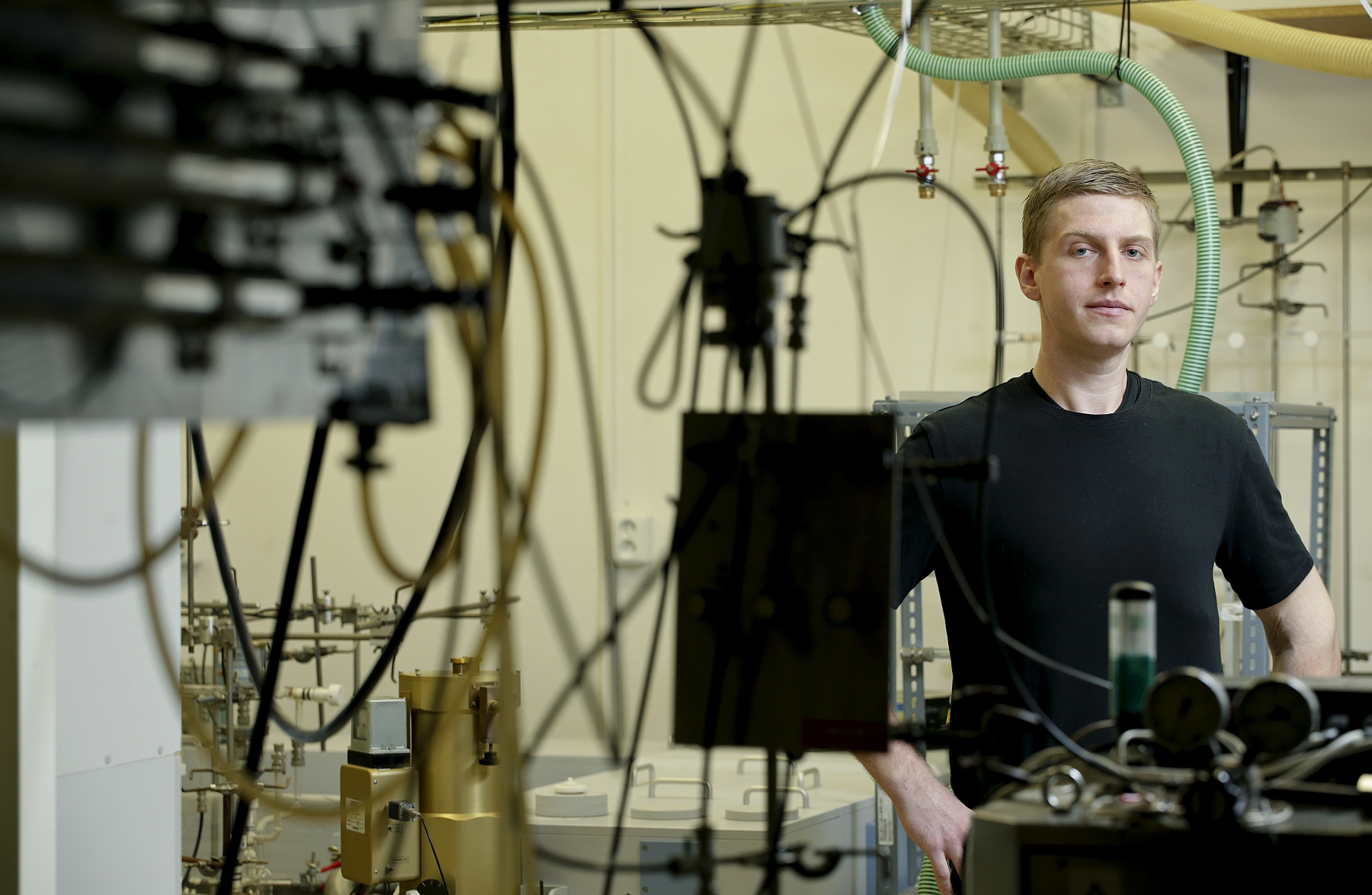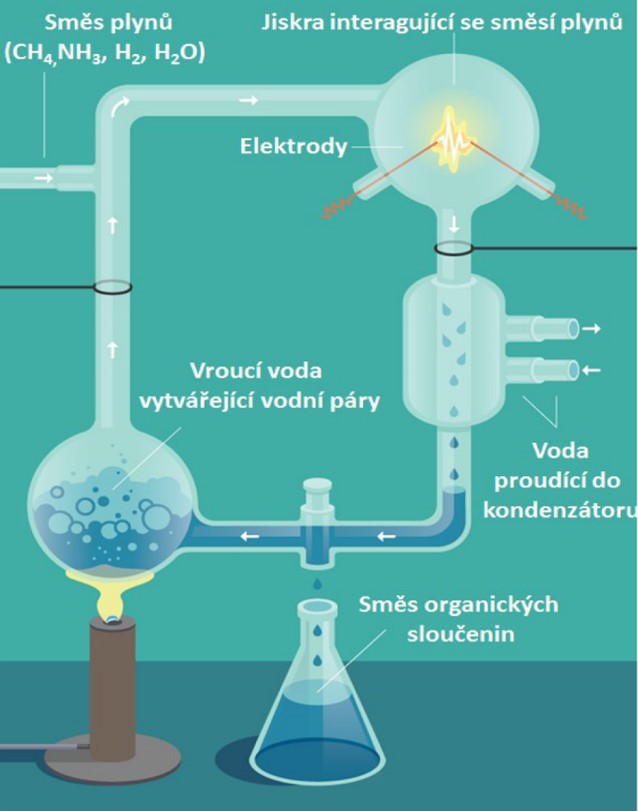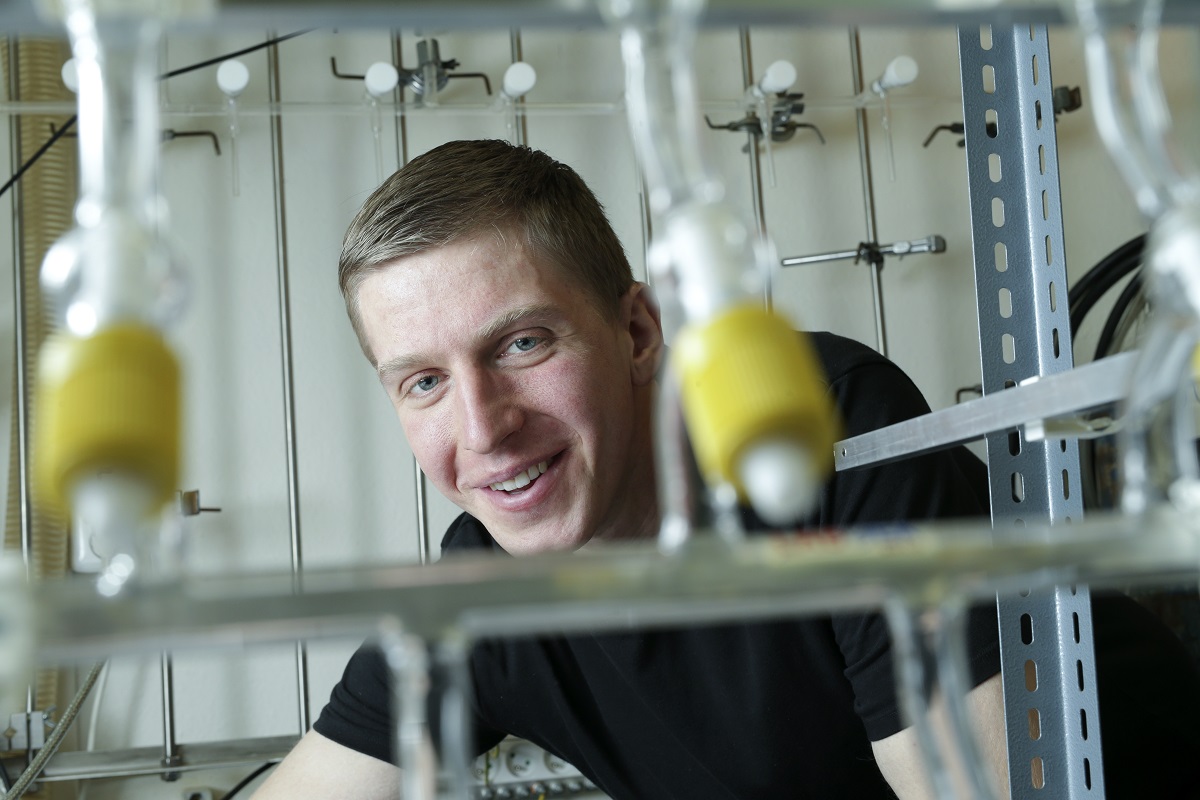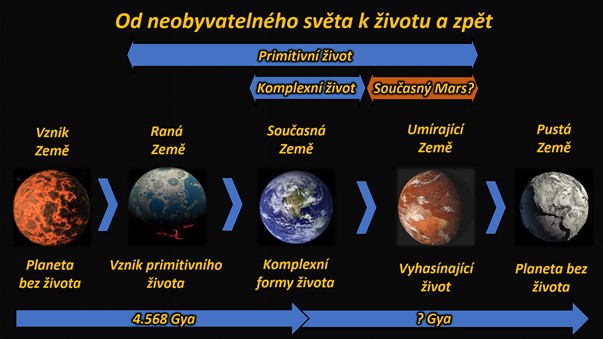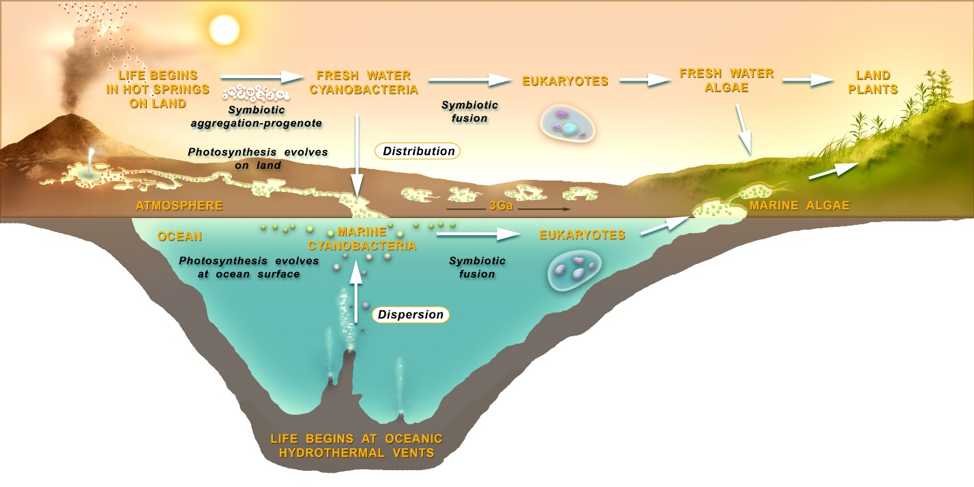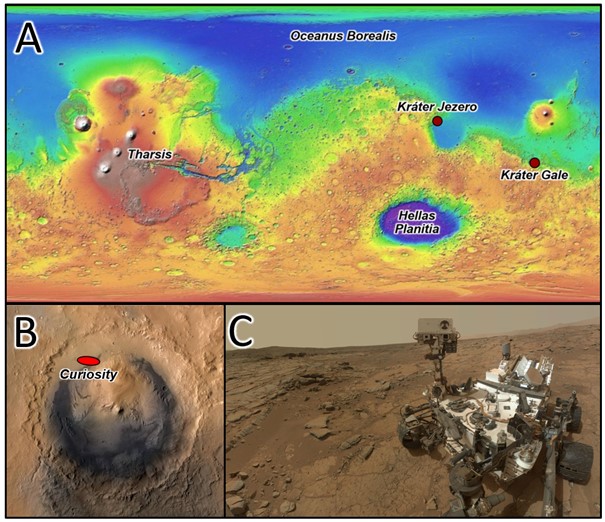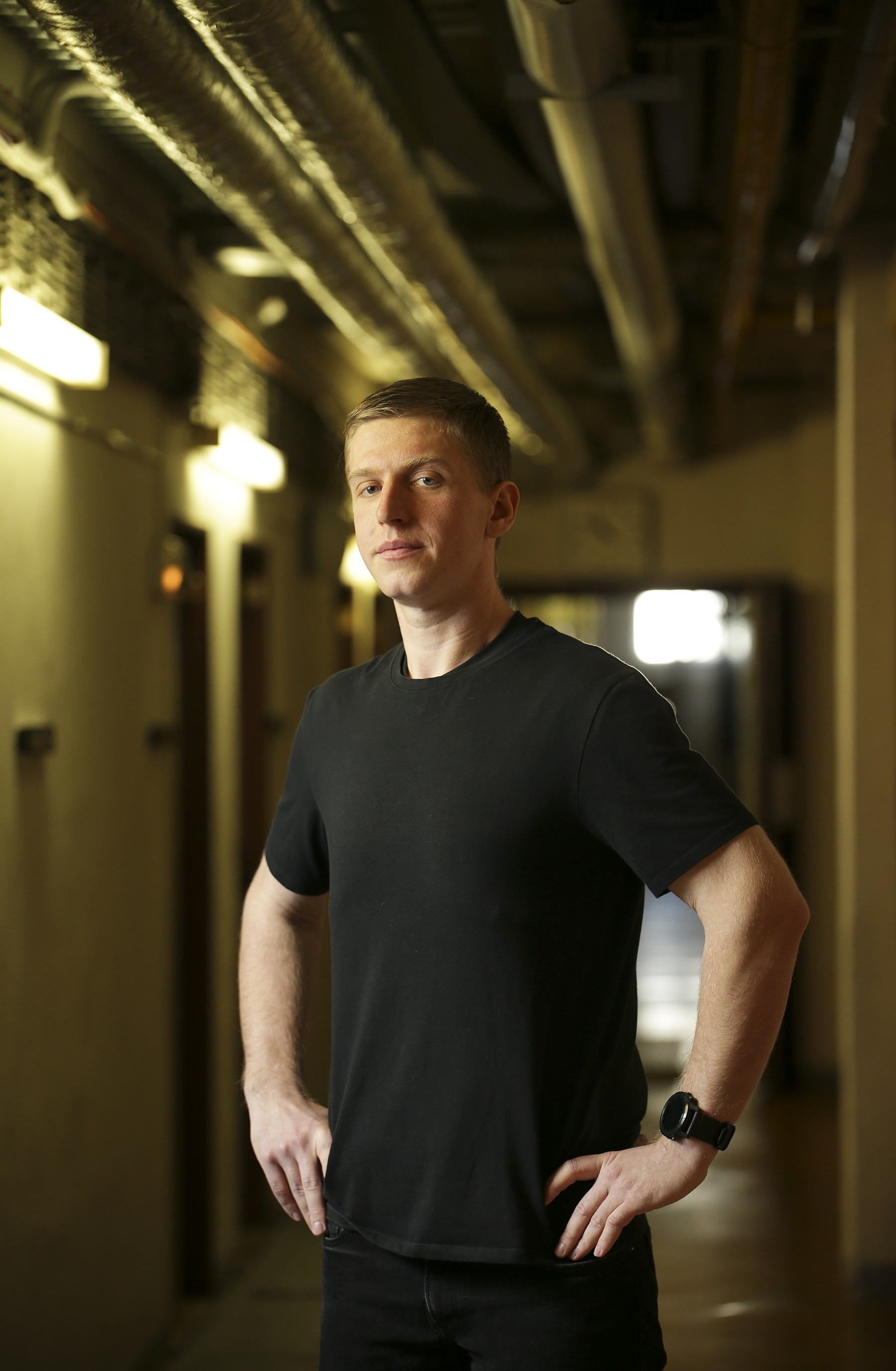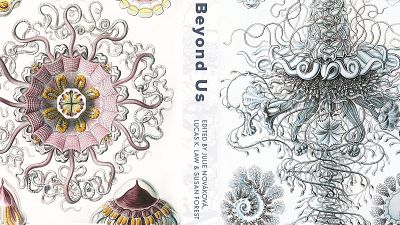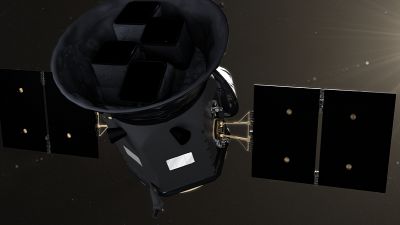As a scientist he is interested in whether the bombardment by asteroids and comets in the early days of the solar system may have led to the start of life on Earth. His thesis on the subject was so impressive it earned the Faculty of Science’s Lukáš Petera the prestigious Werner von Siemens Award in March.
When we met at the J. Heyrovský Institute of Physical Chemistry, the Siemens Award laureate was candid and humble to the point of being almost apologetic: “There were lots of theses that could have gotten the award. It never occurred to me that mine might catch someone’s attention.”
If you were to explain your thesis, titled “The Influence of the Era of Extra-Terrestrial Matter impacts on the Possible Prebiotic Synthesis on Early Mars and Earth” to a layperson or a child, which would it be closer to: a fairy tale or a horror?
That’s hard to say. The beginning of life on Earth – or on any other cosmic bodies – is an extremely complex topic. To even begin getting closer to anything like an answer requires the combination of knowledge across numerous scientific fields. Astrobiology, which deals with the question directly, is a relatively young branch of science bringing together many different areas of expertise: astronomy, physics, geology, biology, as well as my field, chemistry. It can helpful to imagine the beginning and evolution of life on Earth as we know it along a timeline, with simple chemical compounds at the start, which over time and through processes of chemical evolution formed more and more complex (macro)molecular structures such as proteins and the nucleic acids DNA and RNA.
Cooperation between these first “building blocks” eventually led to the first living cells. These cells, through their own biological evolution, also grew more into more and more complex systems which eventually led to more complex living organisms and eventually us, positioned to be able to ask about our own origins and where we came from. Clearly, such complex developments cannot be described from the point of view of one scientific field alone. The more complex the system, the greater the necessity it is to go from physical chemistry to biochemistry to molecular biology and biology…
What then is your role as a chemist?
The study of the first, so-called prebiotic phase. In other words, the period of non-living environments and the first living chemical systems. Prebiotic evolution is divided in a number of steps. Our team studies the very beginning: how simple molecules, such as ammonia, hydrogen cyanide, carbon dioxide, formamide, can lead to the basic building blocks of life. It seems that it depended on nucleobases, nucleotides and their precursors, amino acids, sugars, and lipids.
The synthesis of the building blocks of life in conditions like those present on a much younger Earth is something scientists have been pursuing for decades. The theory of chemical abiogenesis, describing the evolution of biological compounds and inorganic substances was published in 1924 by the Russian chemist Alexander Ivanovich Oparin. The first serious experiment to try and prove his theory was the famous Miller-Urey experiment in 1952, trying to simulate conditions on early Earth as they were thought to have been at the time. This included the presence not only of ammonia but also methane, hydrogen, vaporised water (steam) in a simulated atmosphere as well as liquid water representing the first primordial oceans, seas, and lagoons.
Two electrodes built into the apparatus simulated lighting over several days. After a few days, it became apparent that basic amino acids had formed inside. Later, it was proven that under such conditions all essential amino acids and sugars form. Miller’s experiment pointed the way to the basic building blocks of life.
But that was almost 70 years ago.
Certainly, but of course since then we have continued to learn much more and made modifications and progressed from the original experiment. Today we know that not just lightening but also UV rays, solar winds, ordinary heat and plasmas created during impact with asteroids have the same effect on Miller’s chemical mixture. We also know that compounds don’t form only on the surface of planets but in cosmic interplanetary dust which can impact emerging or newly formed planets.
If we come back to our original timeline, you can see that there were more opportunities for possible starts. You can imagine the different factors that eventually led to life taking hold and starting off the evolutionary process.
So it’s not lightning that interests you per se but the impact of other celestial bodies?
Exactly. We are focused on high-energy chemistry from the impact of enormous celestial bodies such as comets or asteroids on Earth. We are also interested in how compounds could have also formed later at impact craters, and what role was played by residual impact heat, various materials, and winds.
We are talking about conditions four billion years ago, a time when a lot of remnants and materials travelled through the solar system. The orbits of the giant planets may have influenced the trajectories of a huge number of asteroids and comets into the inner solar system which bombarded the rock planets: Earth, Venus, Mars. This was one of the aspects I focused on in my thesis.
Besides Earth, why is the study of Mars so important?
Mars is considered a geologically dead planet. Its atmosphere is around 160 times thinner than Earth’s and is 96 percent carbon dioxide. The temperature on the surface ranges between -80 °C and 20 °C. Mars doesn’t have a magnetic field which on Earth acts as a shield from dangerous cosmic rays. Of course, is also lacks an ozone layer which is further protection against stronger UV radiation. There really are a lot of differences.
But four billion years ago that wasn’t the case: there is a lot of research which suggests that at that time Mars and Earth were very similar. Its atmosphere was thicker, there was liquid water on its surface – maybe even a global ocean. And it possibly had a magnetic field as well. Even if the planet lost all of those things, for us it is very important to know it once had them. [Editor's note: The image on the left, below, is from Petera's thesis].
They were similar but different.
What is incredibly important are tectonic plates. The Earth, so far, is the only planet we know in our system that has them. There are some indications they might – might – also be on Jupiter’s largest moon, Europa. Earth’s surface is divided into several lithospheric plates, in constant movement, simultaneously, sometimes crashing up against each other which leads to further phenomena like earthquakes or the creation of new mountain ranges. There is also what is called subduction, when one lithospheric plate slides partially under another at the convergent boundaries: the material created and pushed to the surface becomes part of the surface [as it hardens and cools] while the gap below, a new crust is formed. The crust is constantly recycled. While it is possible in some places on Earth to find minerals that are older than four billion years old, it is extremely rare. That is why we can’t study the [original] traces of impact craters from the era of bombardment and traces of prebiotic chemistry. This process is ongoing but very important for the habitat’s chemical balance.
Does that mean that craters on Mars are more suitable for research?
Mars does not have tectonics (even if there is still active scientific discussion over whether it did in the past). At least two-thirds of the Martian surface is older than 3,5 billion years and the impact craters there from early Mars are easily observable. Impact craters could have played an important role in the start of life on Earth, so if you consider that conditions on both planets were once similar, there is a lot we can learn: either, that there were also factors or conditions on Mars that were negative for life, or that prebiotic chemistry traces there were perfectly “preserved”. It could be a kind of “museum” of prebiotic chemistry and current and future research there could tell us a lot about how life formed.
As for researchers, we are labourers trying to create or recreate the building blocks of life from non-living matter. You take a mix of basic chemicals, add minerals, clays, and meteorite samples, and hit it with lasers to simulate impact plasma. Then you can only wait, and see if one day a similar product is found on the surface of Mars. [Editor's note: The diagram below uses images from astrogeology.usgs.gov, jpl.nasa.gov, nasa.gov. which were used in Petera's thesis].
So it’s not the end of your research project but only the beginning.
Absolutely! New discoveries are being made and our knowledge deepened; sometimes you have to look at things completely from a new angle and find new connections. Research is like putting together a huge puzzle: sometimes you find pieces that don’t fit but come into play later, you never know. Or researchers might not agree on details of certain “pieces” and their significance. We are limited by data from cosmic research which is the most important of all. I believe our experiments and research are adding important findings, but whether we will make a breakthrough within a few years, or everything changes by then, who knows?
No offence, Lukáš, but it seems like you are almost playing in the lab…
(burst of laughter) That’s fine, that one way of describing it. You can’t do science on a punch clock, you don’t punch out at the end of the day with a completely clear mind. Also, sometimes developments in the lab require you to stay longer: it’s easy in the middle of an experiment to lose track of the time and suddenly it’s midnight. A couple times I stayed until morning measuring results. Everyone has to turn off at some point but a lot of the time you are still running scientific problems through your head even when you are not at work.
In one respect, though, science is no game. I achieved success but research is not always successful. You aren’t always awarded a grant, not every article is published in a prestigious magazine, and not all your results are always significant or if they are, appreciated by the public or colleagues. It’s a psychologically tough environment which sees a lot of people also leave science in pursuit of something else.
Would you be interested in doing research for NASA?
Of course I’d be happy to see a different slice of the world, but am not thinking about any changes at the moment. A lot of people visualise their dream overmuch and chase it all their lives. But when they finally succeed, they find it didn’t come with many of the expected rewards. Chasing something blindly, I think misses one of the most fundamental aspects of human activity: the journey. It’s not the end that is the most important but the process of getting there. I know, it’s a cliché, but I think it is important to realise that we can often be slaves to our dreams.
I try to be happy with where I am at present and grateful for what I have achieved, such as successfully completing my degree. Who knows where it will lead? In 10 years’ time, the origins of life may still be my focus or for all I know I could be shearing wool from sheep in New Zealand. I’ll wait for what comes my way.
How do you explain the success of your thesis?
It is definitely an attractive topic. Scientists who study subjects that are difficult to explain in detail, which are not as immediately attractive, they usually cannot count on getting the public’s attention. But one has to understand that it is often this kind of research, less interesting for the public, but fundamental which is very important, gathering and providing basic data which can then be applied in additional studies and experiments. The scientific community certainly understands and appreciates the significance.
The thing that I like most about my field is how so many different areas of sciences criss-cross and you realise you couldn’t advance alone but only together. Even as first-years, we used to gather and debate and discuss which was “cooler”, chemistry or physics, chemistry or biology… and if chemistry, inorganic or physical? But the more you learn, and from my perspective at the institute, you arrive at one conclusion: everything is connected.
What I want to say is that while I wrote my thesis myself and conducted my own experiments, I couldn’t have achieved anything without my colleagues and help from people outside of our laboratory. For example, colleagues at the Mendel University in Brno, who provided analysis, or the observatory in Valašské Meziříčí, thanks to whom we can measure emissions of meteor spectra, or theoretical scientists at the University of Cambridge who are modelling planetary atmospheres. Their help made a difference: I am really just one link in a longer chain.
| Lukáš Petera, Masters Degree in Chemistry |
| Lukáš Petera was originally interested in studying toxicology at the Faculty of Science at Charles University before turning to research into the building blocks of life. He completed his thesis at the J. Heyrovský Institute of Physical Chemistry and in March was presented with the prestigious Werner von Siemens Award. When not doing science he enjoys taking walks in nature. His weakness, he says, is impatience, but his strength is the verve with which he conducts research and self-motivation. His thesis supervisor, Martin Ferus, describes him as “a workhorse with science in his heart.” |


